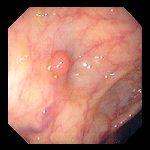Hyperplastic Polyp
What is Hyperplastic Polyp?
Hyperplastic polyp is one of the types of colon polyp. These polyps are usually harmless but can also become cancerous if not treated early.
Other types of colon polyps are adenomatous polyps which are malignant; they account for most cases of cancer. Inflammatory and hamartomatous are the other forms of colon polyps.

Introduction
Large intestine is also known as colon. It is the last part of your digestive system. The first portion of the large intestine is called cecum and connects to the last part of small intestine (ileum).
Other parts of the large intestine include: ascending segment, which is on the right side of the abdomen; transverse is found across the abdomen; descending portion is on the left of the abdomen and sigmoid which is ahead of the rectum. Rectum is the last portion of the large intestine.
Large intestine consist of muscles which extract salt, water from food and keep waste materials until they are ready to be leave the body.
Abnormal tissues can form on your large intestine lining. These growths of tissues are known as polyps. Polyp protrudes outward from the colon wall. Polyps can develop in any one, although middle aged and older people are more likely to have one or many polyps.
Causes
You are at risk to develop hyperplastic polyp if you
- Smoke cigarette
- Eat food that has little or no fiber
- Eat red meat
- eat a diet with high fat
- drink too much alcohol
- Are obese or you are overweight.
- Are above 50 years of age
- Do not regularly exercise
- You come from a family that has a history of cancer or polyps.
Hereditary polyp disorders
Colon polyps are rarely inherited. However an individual can get hyperplastic polyp if any member of the family has a history of the following inherited disorders:
- Lynch syndrome
- Familial adenomatous polyposis (FAP)
- MYH-associated polyposis (MAP)
- Gardner’s syndrome

Symptoms
Most colon polyps do not show any symptoms. However when they finally do, you were stool may change color.
Diagnosis
Colon polyps can be diagnosed through the following:
Endoscopic colonoscopy
In this procedure, your doctor puts a colonoscope through your anus into the large intestine and checks for any abnormalities. Once the polyps are found, your doctor extracts the tissue for analysis to confirm if it is cancerous.
Virtual colonoscopy (CT colonography)
In virtual colonoscopy, the doctor uses a CT scan to view your large intestine. Once the polyps are identified, your doctor uses a colonoscopy to extract the polyp.
Treatment
The common treatment for hyperplastic polyp is by removing it. This can depend on the size and location of the polyp in your large intestine. The following methods can be used to treat hyperplastic polyp:
Laparotomy
This is a surgical procedure conducted by cutting a hole in your abdomen to examine organs in the abdomen including the digestive tract. Before the operation, you will do the following:
- Stop eating anything for several hours
- You will empty your large intestine. Your doctor will give you enema or any other type of bowel medication to clean the colon. Presence of bowel in the colon obstructs your doctor from viewing clearly the inside of your large intestine.
- Your doctor can recommend you to an anaesthetist. The professional will determine your readiness for the operation as well as whether you are allergic or not.
Procedure
Once you have finished preparations, your doctor injects anaesthesia into your vein to relieve pain during the operation. Your doctor makes an incision in your abdomen and exposes the large intestine.
Once the polyp is identified, your doctor extracts it by using a pair of biceps or wire snare.
Side effects
Complications can arise from laparotomy surgical procedure. These complications include:
- Bleeding
- Pain in the abdomen
- Some of your internal organs can be damaged during the operation.
Polypectomy
This procedure is used to extract most of the colon polyps. In this procedure, your doctor puts an endoscope which has a camera through your anus.
The camera enables your doctor to view clearly inside your colon and notice any abnormal growth of tissue. Depending on the size of the polyp, your doctor can use a pair of biceps to extract smaller polyps.
While for larger polyps, a procedure called laparoscopic polypectomy is conducted. In this procedure, your doctor cuts small holes on your abdomen to allow the camera and surgical equipment to pass through.
The laparoscope and other surgical tools are then inserted through your abdominal wall and your doctor extracts the polyps.
Resection
These are procedures performed to treat and prevent conditions affecting your large intestine such as cancer.
For colon cancer, colectomies are done to determine the characteristics of non-cancerous lesions and those that have the potential to become cancerous.
In this procedure, part or entire colon is removed depending on the number of polyps affecting the colon.
When your entire colon is removed, your doctor creates a pouch from the small intestine to the anus to allow waste materials to leave the body.
Your doctor will then take all the removed polyps to a pathologist for analysis. The pathologist assesses the polyps for any signs and symptoms of colon cancer.
When the results are ready, your doctor will schedule an appointment to discuss the results with you. Depending on the result, your doctor may suggest regular screening to monitor your colon cancer as well as your health7.
Prevention
Regular screening for colon cancer is the best option to manage this condition. Screening will help your doctor identify polyps in early stages (benign) and extracts them before becoming malignant or cancerous.
- Eat food with low fat as well as increase your intake of high fiber foods.
- Avoid smoking and reduce the amount of alcohol you drink.
- Come up with a plan to help you exercise regularly. Exercising can help you reduce weight, strengthen your muscles and lower your risk of cardiovascular diseases.
Reference List
- Hyperplastic polyp. Available at http://www.cblpath.com/uploads/Hyperplastic_Colon_Polyps.pdf
- Hyperplastic Polyps of the Colon. Available at http://www.dovemed.com/diseases-conditions/hyperplastic-polyps-of-the-colon/
- Colon polypectomy. Available at http://www.dartmouth-hitchcock.org/gi/colon_polypectomy.html
- Colon polypectomy. Available at http://www.stmarkshospital.nhs.uk/services-a-z/wolfson-unit-for-endoscopy/polypectomy/
- Colon polypectomy. Available at http://www.endoscopy.wiganleigh.nhs.uk/Sigmoidoscopy/what-is-a-polypectomy.aspx
- Colon polypectomy. Available at http://www.wkhs.com/Cancer/Cancer-Treatment-Services/Surgery/Resection/Colon-Polypectomy.aspx
- Laparotomy. Available at https://www.betterhealth.vic.gov.au/health/conditionsandtreatments/laparotomy
- Colon Resection. Available at http://emedicine.medscape.com/article/1891505-overview#a2
